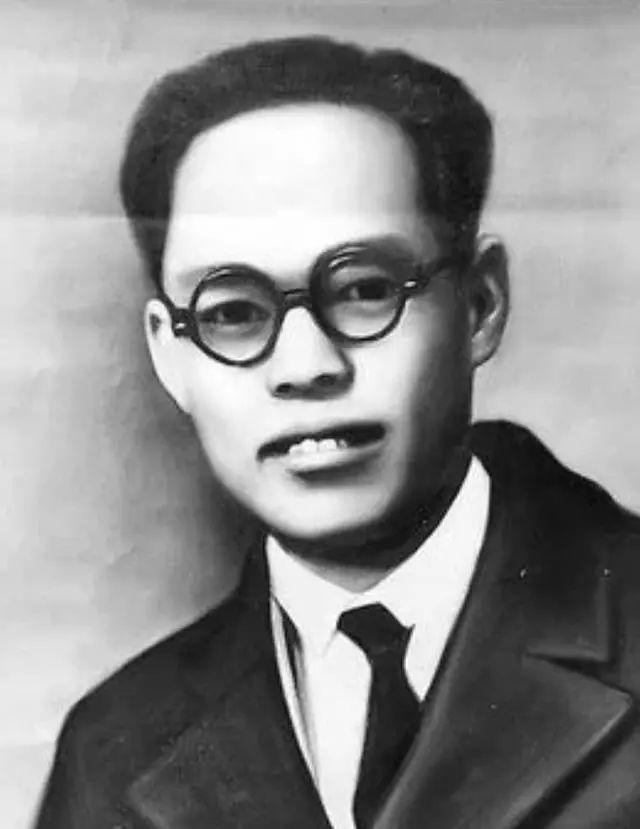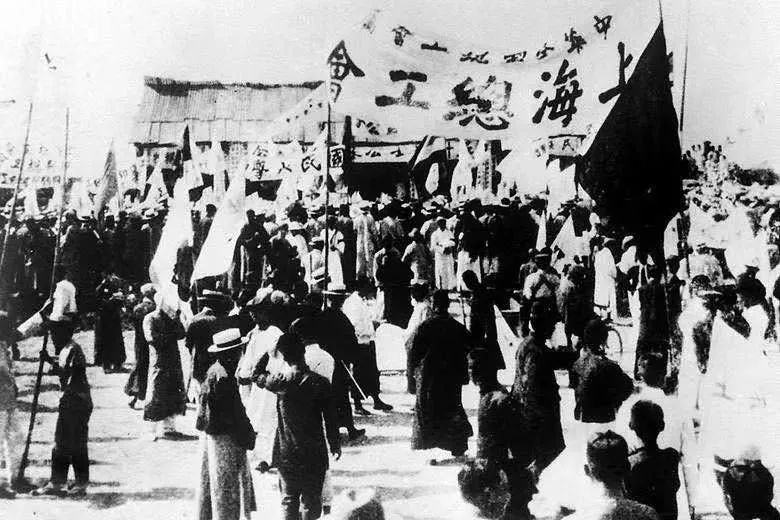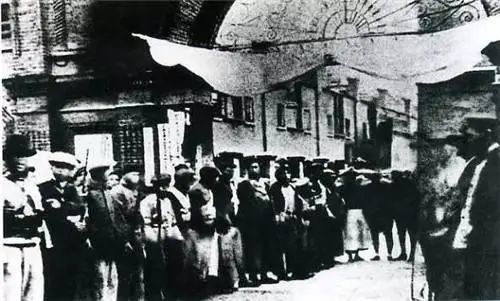编者按:时值建党百年,为实现党建联动区域化、促进党史教育机制化,上海外国语大学与上海龙华烈士陵园举办签约共建仪式,开展建党百年专题活动,引导广大青年在学思践悟中传颂先辈故事、坚定理想信念。上外英院龙陵青年志愿服务队从译介角度进行实践,讲演中国共产党人的革命故事,积极推广文化译介新理念,助力红色文化“走出去”。

图为上海工人第三次武装起义胜利后,上海特别市临时市政府第一次执行委员常务会议与会人员合影(前排右四:身着此套长袍马褂的罗亦农)
朗读者:2020级硕士生 张柳

图为罗亦农穿着的长袍
此两件文物为一套,年代为新民主主义革命时期,其中长袍质地为蓝灰直贡呢,右开斜门襟,共有5个一字形盘纽。内衬面料为藏青色,马褂质地为毛葛,衣襟从上至下5个一字形盘纽。
These two pieces of cultural relics in a set were made in the era of the New Democratic Revolution. The long gown, made of blue and gray Venetian, has a diagonal placket on the right, with five I-shaped buckles in the traditional Chinese style. Its lining is navy blue. The jacket, made of poplin, has five top-down buckles in the same style.
这套衣服是1927年3月罗亦农参加上海特别市临时市政府成立典礼时穿过的,并有穿着时的照片留存。该文物是对大革命时期中国工人运动的一次伟大壮举——上海工人第三次武装起义胜利的见证。
This set of the garment was worn by Luo Yinong when he attended the inauguration of the Shanghai Special City Government in March 1927, and a photograph of him wearing it was preserved. It is a testimony to the victory of the Third Armed Uprising of the Shanghai Workers, a great feat of the Chinese workers' movement during the Revolution.

图为罗亦农像
罗亦农(1902-1928),湖南湘潭人。1921年留俄期间加入中国共产党,任中共旅莫斯科支部书记。1925年回国,12月任中共江浙区委书记,1927年参与领导上海工人三次武装起义,同年任中共中央组织局主任。中共第五届中央委员,八七会议当选中央临时政治局委员,后任中央临时政治局常委。1928年在上海被捕,后于上海龙华就义。
Luo Yinong (1902-1928) was a native of Xiangtan, Hunan, a province in the South Central China region. In 1921, he joined the Communist Party of China during his stay in Russia and served as a secretary of the Moscow Branch of the Communist Brigade. In 1925, he returned to China and became the secretary of CPC Jiangsu and Zhejiang District Committee in December. In 1927, he led the Third Armed Uprising of Shanghai workers and became the director of CPC Central Organization Bureau. He was also a member of the fifth CPC Central Committee. On August 7, he was elected to the Provisional Political Bureau of the CPC Central Committee, of which the Standing Committee he joined afterwards. In 1928, he was arrested in Shanghai and was later executed in Longhua, Shanghai.

图为上海工人第三次武装运动
1926年8月,由罗亦农任书记的中共江浙区委根据中央军委的指示,组织了上海军事委员会,准备开展工人武装起义以配合北伐,推翻军阀统治。在上海工人连续举行三次武装起义的斗争中,罗亦农几乎倾注了全部的心血。起义前夕,除了在市内的大量活动外,他还挤出时间赴外地检查工作,统筹江浙区各地工作,但因为种种原因,前两次的武装起义都以失败告终。
In August 1926, under the direction of the Central Military Commission, the District Committee led by Secretary Luo organized the Shanghai Military Committee. They staged the workers' armed uprisings and cooperated with the Northern expedition to overthrow the warlords. Luo spared no effort to lead three successive uprisings in Shanghai. On the eve of the uprising, in addition to a large number of activities in Shanghai, he also went to other regions for further check and arrangement. However, because of a variety of reasons, the first two uprisings ended in failure.

图为工人武装队伍在上海总工会大门口
在总结了两次起义失败的教训后,中共中央和上海区委召开了联席会议,会议决定,成立以周恩来、罗亦农等8人为委员的特别委员会作为领导起义的最高机构,下设特别军事委员会和特别宣传委员会。1927年3月中旬,周恩来、罗亦农等认为时机成熟,决定全力组织总同盟罢工,并举行武装起义。按计划,起义分为7个区进行,罗亦农负责南市区。3月20日,他在老西门召开了南市区党员、积极分子和工会负责人会议,进行动员和布置。21日凌晨,江浙区委委员、各部委书记召开紧急会议。会上,罗亦农发布命令:“今天正午12点,全市实行总同盟罢工,并同时举行武装起义。”会上还宣布周恩来任总指挥,罗亦农负责联络和处理机关事务。当天12时,上海80万工人开始了总同盟罢工。下午,除敌人巢穴所在地闸北区的战斗仍在继续外,其他6个区的战斗均已胜利结束。罗亦农随即调集了沪东、虹口、沪西3个区的工人武装支援闸北。晚上,敌人开始火烧闸北火车站附近的民居,趁火反扑。罗亦农和秘书赶到前线配合指挥战斗。面对大火,他对秘书说:“什么都不要怕,那里有群众,大火是可以扑灭的,最后的胜利是属于我们的!”经过两天一夜的战斗,解放了除租界以外的整个上海市区,上海工人取得了武装起义的伟大胜利。当天,上海工商学各界举行市民代表大会,选举产生了由罗亦农等19位委员组成的上海特别市临时市政府。罗亦农在大会上宣布了市民政府成员的名单,并发表了鼓舞人心的演讲,他说:“现在的上海,不再是帝国主义、北洋军阀的上海,是工人阶级的上海!”
Lessons learnt, the CPC Central Committee and the Shanghai District Committee held a joint meeting and decided to set up a special committee of eight members, including Zhou Enlai and Luo. There were also a special subsidiary military committee and a special subsidiary propaganda committee. In mid-March 1927, Zhou, Luo and the others thought it was the right moment to take action. They decided to make every effort to organize the general union strike and launch an armed uprising. As scheduled, the uprising would be staged in seven districts. Luo was in charge of the southern district. On March 20, in order to mobilize and arrange the workers, he held a meeting at Laoximen among the party members, activists and the Trade Union leaders of the southern district. On March 21, Jiangsu and Zhejiang district committee members and secretaries of ministries and commissions held an emergency meeting at dawn, during which Luo issued an order: "A general union strike is to start at 12:00 together with an armed uprising." Zhou was announced as the general commander and Luo was in charge of liaison and government affairs. At 12 o'clock, 800,000 workers in Shanghai started the strike. By the afternoon, the fighting had ended in success in all districts, with the exception of Zhabei, where the enemy's lair was located. Luo then mobilized workers from three districts, Shanghai East, Hongkou and Shanghai West, to support it. In the evening, the enemy began to set fire to the dwellings near the Zhabei Railway Station in the hope of fighting back. Luo and his secretary rushed to the front and, in face of the big fire, he said, "Don't be afraid of anything. As there are the masses, the fire can be put out and the final victory will belong to us!" After two days and a night of fighting, workers achieved a great victory and liberated the entire Shanghai urban district except the foreign concessions. On the same day, people from all walks of life in Shanghai held a citizen's congress and elected 19 members, including Luo, to constitute the Shanghai Special City Government. At the congress, Luo announced the list of members of the civil government and made an inspiring speech. He said, "Today's Shanghai is neither the imperialist's nor the warlords' Shanghai, but the working class’s Shanghai!"
1927年4月,罗亦农牺牲后,其生前衣着用品均由妻子李文宜收集、整理并保存,曾先后置于杨之华、邓颖超等人的秘密居所。后李文宜赴莫斯科学习,罗亦农遗物曾转存在李文宜本家亲属处。1992年,由李文宜捐赠给上海市龙华烈士陵园筹建办。
In April 1927, after his death, Luo's clothes were collected and preserved by his wife, Li Wenyi, and were successively placed in the secret residence of Yang Zhihua, Deng Yingchao and others. Later, since Li went to Moscow to study, Luo's relics were transferred to Li's relatives. In 1992, they were donated by Li to Shanghai Longhua Martyrs Cemetery preparation office.
我要评论 (网友评论仅供其表达个人看法,并不表明本站同意其观点或证实其描述)
全部评论 ( 条)